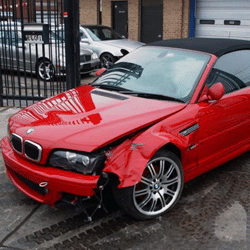One of the most basic tasks in auto body repair industry is removing and repairing auto body rust. Rust usually appears on car when the paint has been chipped, usually by a rock, or scratched. Exposed metal will eventually start corroding and ugly rust sop will appear. Nasty thing about the rust is that it tends to spread and a very small spot will grow rather quickly, completely ruining your paint job unless it is taken care of.
Fortunately, this is easily fixed, even if you have little experience in auto body repair work. There are few simple steps that can help you remove those eye sores from your car.
1. First thoroughly wash the area around the rust spot. Make sure you use some sort of degreaser, any household dishwasher detergent will do.
2. Next step is masking. This step is important for two reasons. It will protect the surrounding area from any accidental damage, like tools scratch marks or even spilled paint (been there, done that, not funny at all.). Another reason is to provide you with an area that will be easy to blend once painted. We’ll cover that part a bit later. Right now, it is important to mask an area that won’t be too noticeable. This depends on the size of the rust affected area of course. Try using borders that already exist on the car, like edges or lips. For instance, if your rust spot is located on the bottom of the door, mask off entire lower door section and not just the area immediately around the spot.
3. Now it is time to remove the rust. Use an electric sander for this, starting with low grit and work your way up. Don’t worry if you take out surrounding paint in the process, in fact you may need to do it depending on how much the rust has spread. Once you have reached healthy bare metal, it is time for the next step.
4. Buy a can of body filler and carefully apply it. You need to cover the entire area you have sanded off. Leave it to dry for 24 hours. Arm yourself with patience and start sanding again, starting with rough grit and working your way up. Make sure you are wearing a mask while doing this; you don’t want to inhale all that dust. The area needs to be absolutely smooth in order to be ready for painting.
5. Next step is primer. You can get this in an aerosol can. Apply it over the area and leave it to dry for at least 24 hours.
6. Now you are ready for paint. Each paint has its own code. You can usually find it on the inside of a gas tank cap. Take the code to the paint shop and they will mix you an exact shade of paint like the rest of your car and you can get it in a can ready to spray. When spraying, keep in mind that it is better to use two thin layers instead of one thick layer. Again, leave it to dry for 48 hours. Then apply clear coat.
In order to completely blend new and old color, you may need to polish the entire car except the newly painted one. Also, avoid waxing that part for at least three weeks.




 Follow
Follow

